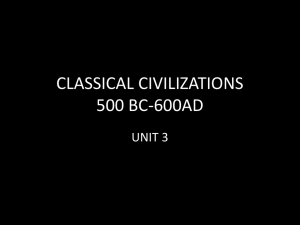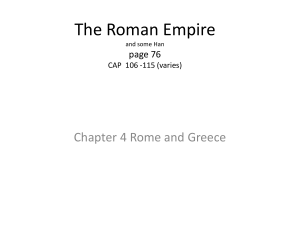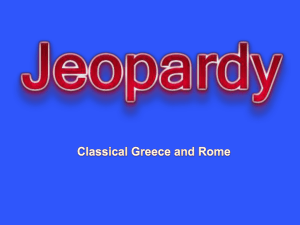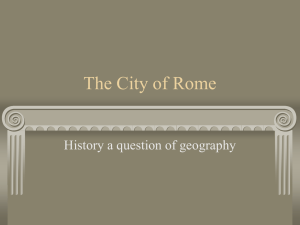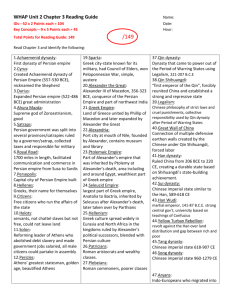Classical Era Test Review Please complete this review IN FULL
advertisement
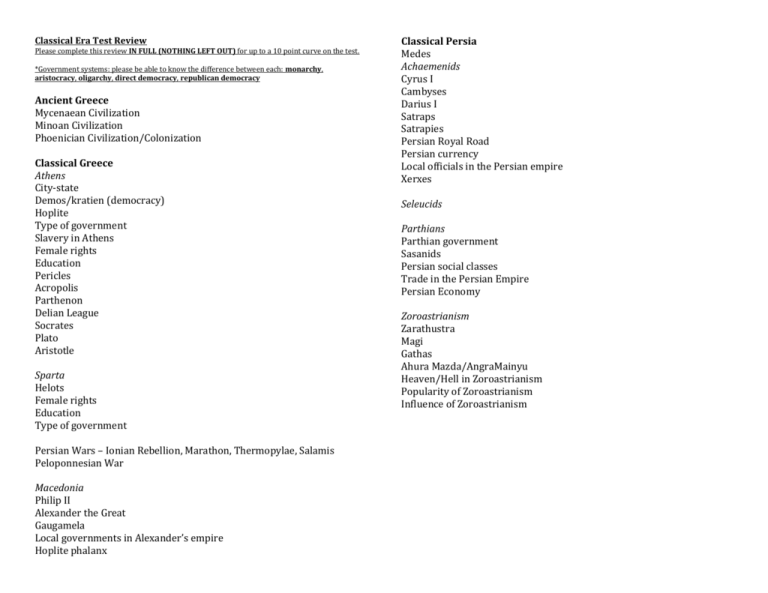
Classical Era Test Review Please complete this review IN FULL (NOTHING LEFT OUT) for up to a 10 point curve on the test. *Government systems: please be able to know the difference between each: monarchy, aristocracy, oligarchy, direct democracy, republican democracy Ancient Greece Mycenaean Civilization Minoan Civilization Phoenician Civilization/Colonization Classical Greece Athens City-state Demos/kratien (democracy) Hoplite Type of government Slavery in Athens Female rights Education Pericles Acropolis Parthenon Delian League Socrates Plato Aristotle Sparta Helots Female rights Education Type of government Persian Wars – Ionian Rebellion, Marathon, Thermopylae, Salamis Peloponnesian War Macedonia Philip II Alexander the Great Gaugamela Local governments in Alexander’s empire Hoplite phalanx Classical Persia Medes Achaemenids Cyrus I Cambyses Darius I Satraps Satrapies Persian Royal Road Persian currency Local officials in the Persian empire Xerxes Seleucids Parthians Parthian government Sasanids Persian social classes Trade in the Persian Empire Persian Economy Zoroastrianism Zarathustra Magi Gathas Ahura Mazda/AngraMainyu Heaven/Hell in Zoroastrianism Popularity of Zoroastrianism Influence of Zoroastrianism Classical India Mauryan Dynasty Bactria Chandragupta Maurya Chandragupta’s government Ashoka Maurya Downfall of Mauryan Empire Buddhism in the Mauryan Dynasty Guptan Dynasty Chandra Gupta (not CHANDRAGUPTA) Downfall of the Guptan Empire Concept of Zero Hinduism in the Guptan Dynasty Long distance trade in Classical India Caste system (5 castes/job description) Jati Vaishya/Shudra prosperity Jainism Vadrhamana Mahavira Jina/Jains Jainist doctrine Ahimsa Buddhism Siddartha Gautama Dharma Monasticism Four Noble Truths Noble Eightfold Path Religious goal of Buddhism Appeal of Buddhism Ashoka Mahayanas Boddhisatva Theravadas Hinduism Mahabarata Vishnu Ramayana Bhagavad Gita Hindu ethics Appeal of Hinduism Classical China Qin Dynasty Shang Yang/Han Feizi Legalism in Qin China Legalist doctrine Basis of Qin economy Suppression of resistance Centralization in Qin China Collapse of the Qin Han Dynasty Liu Bang Han Wudi Han Centralization Legalism in Han China Gov’t monopolies on industry Confucian educational system Imperial expansion Social structure Technological achievements Taxation on commoners/wealthier Chinese Problems with land distribution Wang Mang Collapse of the Han Confucianism Confucius Key Confucian concepts Mencius Xunzi Daoism Laozi/Zhuangzi The Dao Wuwei Daoism vs. Confucianism Classical Rome Republican Rome Foundation of Rome Romulus/Remus Capitoline/Palatine Hills Marcus Junius Brutus/The Republic Etruscan inheritance Roman Forum Roman Government & Administration The 12 Tables Political/civil rights for citizens in Rome/outside of Rome Colonial administration/taxation Roman Government – structure Office of Dictator Basilicas Roman Social Life Patricians Plebians Clientage (Patron/Client rel.) Struggle of the Orders Plebiscite Female roles in Rome Roman Religion Pontifex Roman polytheism Greek/Etruscan inheritance Temple of Jupiter Optimus Maximus Temple of Vesta Roman Culture Historians Roman philosophies Roman bloodsports – evolution Roman economics Battlefield success = Roman soldier/farmer Slave labor Latifundia Political stability & economics End of the Republic Optimates/Populares The Gracchi’s political ambitions Political instability First Triumverate Second Triumverate Principate Augustus’ cult of personality Princeps Pax Romana Moral reforms Virgil/Horace Empire Nero Vespasian/Titus Hadrian Caracalla Barracks Emperors Tetrarchy Diocletian Foederati Constantine Constantinople Edict of Milan East/West split Battle of Milvian Bridge Senate/Popular assemblies in Emipre Economics in the Empire Debasement “mare nostrum” Imperial coinage – uses Grain imports to Rome Caracalla & increasing imperial revenue Emperors & massive public buildings Religion in the Empire Oriental cults Mithras/Isis & Osiris Emperor cults Judaism – diaspora Christianity’s appeal Christian Persecution Toleration of Christianity Christian theological councils St. Jerome Architectural achievements Arches Concrete Pozzolano ash Mining in the empire Roads Aqueducts BIG IDEAS TO REMEMBER IN CLASSICAL CIVILIZATION 1. The Greeks became reconnected with the Mediterranean & left the dark ages after Phoenician traders began trading throughout Greece & the eastern Mediterranean. The Greeks also borrowed the Phoenician alphabet & combined it with their own characters to make it their own. Rome will later preserve the Greek legacy. 2. Greek rationality and philosophy is the basis of modern western philosophy. The unexamined life isn’t one worth having. Emphasis on reflection/morality/ethics/perception. 3. Greeks colonized the Mediterranean/Black Sea area for economic reasons just after the Dark Ages and onward. 4. The Persian Empire was the largest the world had seen prior to Alexander’s conquest of Persia and the Roman Empire. The further local rulers were away from Persepolis (& later Ctesiphon), the more autonomy they had – as long as they paid their share of taxes. 5. Alexander’s empire extended from Greece to India, Egypt to Afghanistan. He did this all before he was 33, & was successful governing by delegating power to Greek officials he placed in conquered lands. 6. Rome started off as a small collection of tribes in the middle of the Italian peninsula and then conquered surrounding peoples, Italy, and then looked beyond after the Second Punic War. The empire at its greatest length extended from Spain to Mesopotamia, Britain to Egypt/Northern Africa. 7. Roman government was complex. It had elements of monarchic, democratic, and oligarchic rule. The Senate was strong during the Republic, but by the Empire had become merely symbolic. Popular assemblies were used during the early Republic, but also became symbolic in the Empire, when only the Emperor’s wishes mattered. 8. Roman law and republican government will be the basis for western law & government to this day. The Romans had a complicated, but fair, legal system. The Law of the 12 Tables was the first form of that system that was later codified by the Byzantine Emperor Jusitinian ~530 CE. 9. Rome’s control of the Mediterranean/their roads facilitated trade. Security by the army/political stability promoted trade, instability & invasion killed trade. The empire will end due to economics – little money to pay the troops, feed the people/invaders – too few troops to guard the borders, protect the people. 10. Geography, social hierarchy, language, & varied economies led to political disunity in India prior to the Mauryans & Guptans. 11. Both the Mauryans and Guptans saw their empires collapse because of outside invasions. The Mauryans also dealt with the high cost of maintaining its vast borders. 12. Women’s roles in India changed as social changes occurred. They were more and more expected to be docile & subservient to men. Buddhism/Jainism gave women a bit more freedom than Hinduism. 13. The Qin state was in WEST CHINA & were highly legalist & centralized. This caused much upset within the Qin people, & the dynasty collapsed due to much forced labor on public works & legalist policies. 14. The Han Dynasty was legalist as well. They were also centralized, but sought foreign expansion. Confucian education was a big part of government for the Han. 15. Much like the Zhou, the Han dynasty fell because of factions (warring parties) in the Han court, which resulted in the fractioning of China into separate kingdoms afterwards. Essay questions: At least half a page for each essay. You may write out these essay questions on a separate 3 x 5 note card to use on the essay portion of the test. 1. Please compare and contrast the decline and fall of three of the seven civilizations we studied in the Classical Era. Give the causes of collapse for each civilization and then analyze their similarities and differences. 2. Why were religions like Christianity and Judaism such a perceived threat to the Roman state religion? 3. Analyze and discuss the differences between Confucianism, Daoism, and Legalism. You will first have to describe the principles of each before you describe their differences. IMPORTANT GEOGRAPHY. Identify on the following map. Ctesiphon Rome Athens Sparta Persepolis Gaugamela Delos Marathon Salamis Alexandria Jerusalem Pella Rubicon River Luoyang Xianyang Hadrian’s Wall Constantinople Etruria Magna Graecia Carthage Macedonia Black Sea Hellespont


